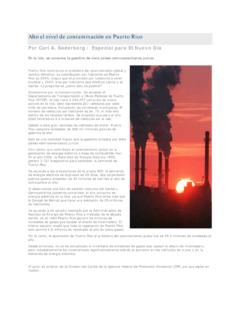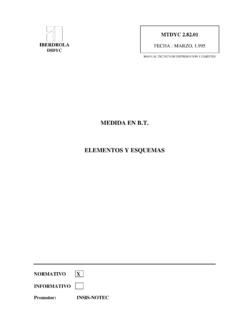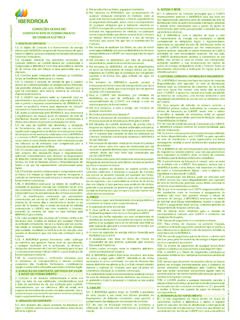Transcription of Wind Power in Spain - Alianza Ciudadana para la …
1 Special Ad SectionWind Power in SpainFor governments and companies committed to the idea of powering our technological age with clean, renewable energy, wind Power is a natural fit. wind -powered technology has matured over the past two decades, driving down costs and driving up efficiency. Today, countries like Denmark and Germany have demonstrated that integrating a Power source such as wind into the grid can easily provide more than 20 percent sometimes significantly more of the Power needs of a given region. Now, Spain has joined them as a wind -energy powerhouse. With 9,000 megawatts of installed capacity, Spain ranked second in the world in 2005 in total installed capacity, behind Germany (16,000 megawatts) and ahead of the United States (6,500 megawatts). Furthermore, Spanish companies, both turbine manufac-turers and wind -farm operators, are among the leaders in the global wind - Power market.
2 Some examples are Gamesa E lica (world s second largest turbine manufacturer), Iberdrola (world s largest wind -farm owner and operator) and Acciona Energ a (world s largest wind -farm builder and developer). What s more, from the dense industrial base already present in Spain , many companies have sprung up to develop technologies befitting the needs of the wind industry, in fields such as compos-ites, steel, electrical components, and wind -data loggers. With 30 percent annual growth in the sector, and a clear commitment from the Spanish government to encourage pri-vate investment, technological advances, and grid development, Spain is poised to continue this trend toward powering its By Cynthia GraberSpain s installed wind - Power capacity makes it the second-largest wind -energy producer in the world, and Spanish com-panies lead the global wind - Power market. This is the first in an eight-part series highlighting new technologies in Spain and is produced by Technology Review s custom-publishing division in partnership with the Trade Commission of Spain .
3 Canary Islands wind Ad Section01020304050economic and technological growth with the strong winds that sweep over the country s mountains and plains. wind Power Is an Economic Winner in SpainOne reason Spain stands out from other European leaders in wind Power , according to Corin Millais, head of the European wind Energy Association, is that environmental issues have not been the major driving force behind this expansion. It s much more a story about regional growth, economic deployment, driving an economy that requires increasing amounts of energy, said Millais. There s more of a fundamental value of wind Power to an economy in Spain than in northern Europe. And the figures in Spain support this claim. When the first renewable energy plan was enacted in the late 1990s, energy demand was predicted to increase by percent per year. In-stead, demand has grown by around 3 to 4 percent. In addi-tion, wind Power has grown much more rapidly than expected, with installed capacity increasing by about 30 percent per year.
4 Currently, the government estimates that 300 to 400 Spanish companies are involved in wind Power , supporting about 30,000 jobs, with that number expected to double by 2010. This healthy job growth experienced as well in other industries has been crucial: a decade ago, the unemployment rate in Spain was more than 20 percent; it has since fallen to percent in 2005. In addition to economic and technological development, wind Power in Spain has transformed the countryside. All along northern Spain s famous Camino de Santiago (St. James Way), an ancient Christian pilgrimage route through the Pyrenees, plains, and along the coastline, ending at the burial site of the martyr St. James in Santiago, pilgrims travel past modern-day windmills. But the transformation has been more than visual, for the income that wind farms bring to poorer rural areas has literally saved some communities. The goals of the Spanish government in promoting wind are twofold.
5 First, to reduce dependency on imported oil. In relation ,629MW8,263 MW6,740 MW3,117 MW3,000 MWThe top five countries listed below account for over 67 percent of total wind energy installation : 2004 American wind Energy AssociationGERMANYS2 Top Five Countries with Highest Total Installed wind Capacity to other countries in the OECD and the European Union, Spain is much more dependent on foreign oil, said Javier Garcia Breva, until fall 2005 director general of the Spanish Institute for Energy Diversification and Saving (IDAE), part of the Spanish government. The country is very vulnerable to variations in the oil market. So, at the first analysis, the renewable energy plan has focused on increasing energy independence in Spain . The second goal, according to Garcia, is equally important: reducing carbon dioxide emissions in line with the goals of the European Union. According to IDAE figures, if Spain meets its goal of generating 30 percent of its electricity needs from renewable Power by 2010, with half of that amount coming from wind Power , it will reduce emissions of carbon dioxide by 77 million tons.
6 A Global TrendThe rapid growth in wind -generated Power in Spain reflects a global trend. According to the Global wind Energy Council (GWEC), wind - Power capacity has been increasing at least 20 percent each year between 2000 and 2005, and wind turbines today can produce 200 times more Power than equivalent turbines two decades ago. The wind - Power sector is coming of age. Its energy is relatively cheap to produce, some of its technologies have matured even though there are several breakthrough tech-nologies being developed in Spain and more countries and communities are turning to wind to reduce both their dependency on foreign fuel and their contribution to global warming. The GWEC expects the costs of Power from wind to be competitive with those from conventional fuel within a decade. In many areas, wind Power is still more expensive than other conventional fuels, though costs have plummeted since the 1980s (when wind Power was in its infancy).
7 Today, according to the American wind Energy Association (AWEA), in the windiest sites, wind Power may sell for around 4 to 5 cents per kilowatt hour, which compares well with energy prices in new coal or gas-fired plants. Recent fluctuations in steel prices have kept wind Power prices steady, rather than continuing this downward trend; but natural gas costs have risen in the same period, making wind increasingly attractive. Today there are more than 50,000 megawatts of installed wind - Power capacity around the world, up from only 17,000 megawatts a decade ago. Surpassing Goals in SpainThe Spanish story reflects those dramatic changes. In 1999, the government set a goal for wind Power at 9,000 megawatts of capacity by 2011. By midway through 2005, however, more than that amount of wind Power had already fed into the Spanish grid, compared with only 800 megawatts in 1999 2000. In response, in August 2005, the Spanish government once Ad SectionS3 Source: AEE/IDAE/REE *Trade Commission of Spain Total jobs in wind industry in 2004 30,000 Jobs projected for 2011 60,000 Castile La Mancha MW Castile and Leon MW Galicia MW Aragon MW Total capacity by end of 2005* 9,500 MW Total capacity target for 2011 20,000 MW Growth rate 2003 2004 33% Contribution to national Power supply Peak contribution to Spanish electricity supply 24% Equivalent number of households supplied 4 million+ Peak generation in 2004 86,775 MW Economic GrowthMarket SnapshotWind Power in SpainEmploymentTop Growth s Installed wind Capacity by RegionSpecial Ad Sectionagain reconsidered its goals.
8 More ambitious numbers were need-ed to reflect the reality of the sector and to assure businesses that the government remained committed to this growth. As a result, a new goal of approximately 20,000 megawatts was set, a leap of almost 50 percent. I believe this is achievable for a very fundamental reason, said Garcia. In Spain right now there is social and political consensus in favor of wind Power . And that, together with the private-sector initiative, makes us very optimistic regarding the future of wind Power . Today, wind Power fulfills about 6 percent of the coun-try s electricity needs (in the United States, for instance, the AWEA s goal is to reach the 6 percent level by 2020). In Navarra, one of the autonomous regions that hosts a great deal of wind - Power development, wind can fulfill nearly half of the region s Power needs. We re talking about a sector today that is one of the most dynamic parts of Spanish industry, said Garcia.
9 Creating and Developing the wind - Power Market in SpainSpain has created some of the world leaders in this industry. In the early 1980s, turbine manufacturer Ecotecnia was one of the first companies to install a wind - Power generator in Spain . The company began in the renewable energies sector, then focused on wind generation when Director Antoni Martinez decided to follow the examples of Denmark and California. According to Martinez, interest and business in wind - Power began to pick up in 1992 and took off in 1997, when the Spanish government instituted a new electricity act. With the act, the government set a fixed premium every year according to the baseline cost of Power from electric utilities, with a premium to ensure profitability for wind farms. In addition, utilities are obligated to buy any wind Power produced and integrate it into the national grid. Ecotecnia is still a major player in the Spanish wind - Power market, selling turbines in Spain and around the world.
10 What s more, the market has expanded to create international Power -houses like Gamesa E lica, major national energy companies such as Iberdrola, and Acciona Energ a, the renewable energies subsidiary of the Acciona Group, a major Spanish business group with thousands of employees. Iberdrola set up its first wind farm in 2000; already by 2005, it had become the largest owner of wind farms in the world. Meanwhile, Acciona Energ a is the largest wind -park constructor and developer in the world. The company credits its success to its beginnings in the region of Navarra in 1994. We were pioneers with a plan of implementing wind Power in Navarra when wind wasn t yet looked on as an important economic sector, said the company s director of marketing, Jose Arrieta. This is giving real corporate credence to the industry. It s bringing in capital and financial sophistication, said Godfrey Chua, principal analyst of Emerging Energy Research, an inde-pendent organization that provides market research about wind Power .








